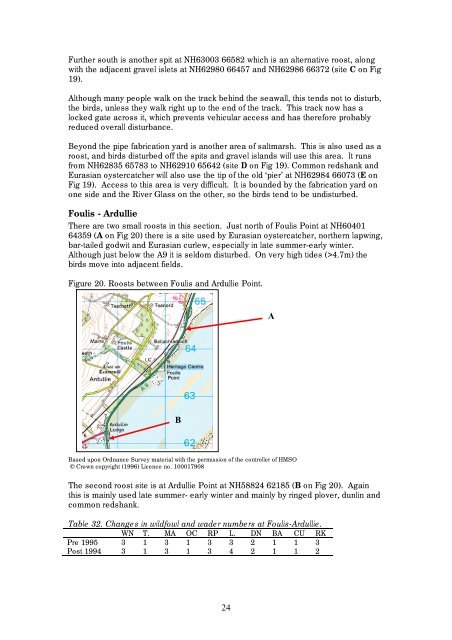Commissioned Report 252 - Scottish Natural Heritage
Commissioned Report 252 - Scottish Natural Heritage
Commissioned Report 252 - Scottish Natural Heritage
You also want an ePaper? Increase the reach of your titles
YUMPU automatically turns print PDFs into web optimized ePapers that Google loves.
Further south is another spit at NH63003 66582 which is an alternative roost, along<br />
with the adjacent gravel islets at NH62980 66457 and NH62986 66372 (site C on Fig<br />
19).<br />
Although many people walk on the track behind the seawall, this tends not to disturb,<br />
the birds, unless they walk right up to the end of the track. This track now has a<br />
locked gate across it, which prevents vehicular access and has therefore probably<br />
reduced overall disturbance.<br />
Beyond the pipe fabrication yard is another area of saltmarsh. This is also used as a<br />
roost, and birds disturbed off the spits and gravel islands will use this area. It runs<br />
from NH62835 65783 to NH62910 65642 (site D on Fig 19). Common redshank and<br />
Eurasian oystercatcher will also use the tip of the old ‘pier’ at NH62984 66073 (E on<br />
Fig 19). Access to this area is very difficult. It is bounded by the fabrication yard on<br />
one side and the River Glass on the other, so the birds tend to be undisturbed.<br />
Foulis - Ardullie<br />
There are two small roosts in this section. Just north of Foulis Point at NH60401<br />
64359 (A on Fig 20) there is a site used by Eurasian oystercatcher, northern lapwing,<br />
bar-tailed godwit and Eurasian curlew, especially in late summer-early winter.<br />
Although just below the A9 it is seldom disturbed. On very high tides (>4.7m) the<br />
birds move into adjacent fields.<br />
Figure 20. Roosts between Foulis and Ardullie Point.<br />
B<br />
Based upon Ordnance Survey material with the permission of the controller of HMSO<br />
© Crown copyright (1996) Licence no. 100017908<br />
The second roost site is at Ardullie Point at NH58824 62185 (B on Fig 20). Again<br />
this is mainly used late summer- early winter and mainly by ringed plover, dunlin and<br />
common redshank.<br />
Table 32. Changes in wildfowl and wader numbers at Foulis-Ardullie.<br />
WN T. MA OC RP L. DN BA CU RK<br />
Pre 1995 3 1 3 1 3 3 2 1 1 3<br />
Post 1994 3 1 3 1 3 4 2 1 1 2<br />
24<br />
A

















